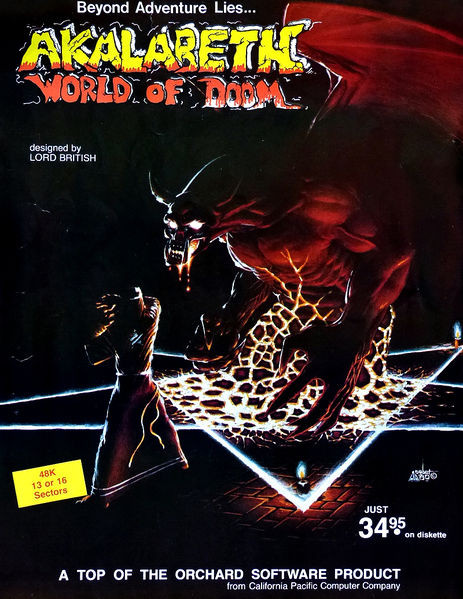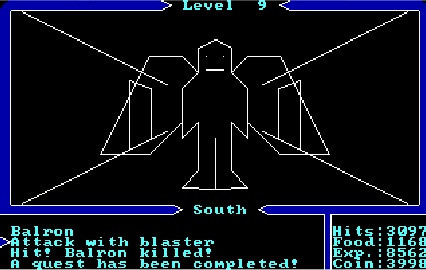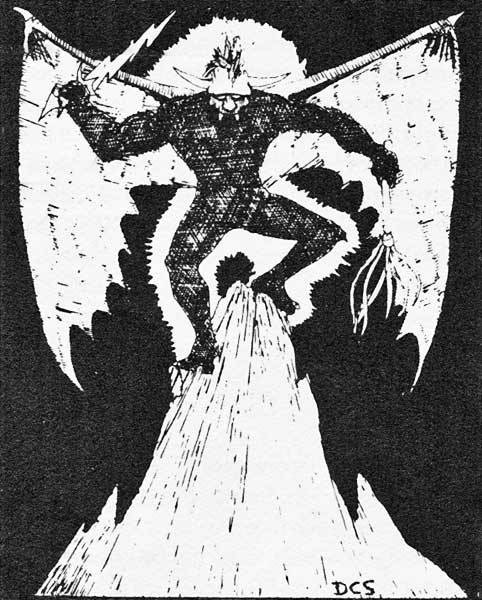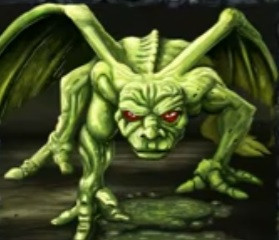When you think of the formidable boxer Balrog from Street Fighter, you might wonder about the origin of his imposing name. While Balrog is a memorable moniker for a video game character, its roots delve much deeper into fantasy literature and gaming history, surprisingly connecting to the works of J.R.R. Tolkien.
The name “Balrog” itself was actually invented by Tolkien for his Lord of the Rings universe, describing powerful demonic creatures of fire and shadow. However, by the time Street Fighter II: The World Warrior debuted, “balrog” had already transcended its literary origin and become a generic term for powerful monsters within the gaming community. Street Fighter II, while popularizing the name to a wider audience, was not the first video game to feature a “Balrog.”
 Akalabeth: World of Doom game poster featuring a Balron, an early example of Tolkien's influence in gaming.
Akalabeth: World of Doom game poster featuring a Balron, an early example of Tolkien's influence in gaming.
Long before Balrog entered the fighting game arena, the term appeared in various other games. Notably, in the original Ultima, the ultimate enemy was a “Balron,” a clear nod to Tolkien’s creation. This influence is even more evident when considering Lord British’s previous game, Akalabeth: World of Doom, which also featured a “Balrog,” although later iterations changed the name to avoid direct Tolkien references.
 Wireframe Balron from Akalabeth: World of Doom, showcasing early video game graphics and Tolkien-inspired monster design.
Wireframe Balron from Akalabeth: World of Doom, showcasing early video game graphics and Tolkien-inspired monster design.
The influence of Tolkien’s Balrogs extended beyond video games, permeating tabletop role-playing games as well. Dungeons & Dragons, a hugely influential game, featured a creature known as the “Balor,” or sometimes “Balrog,” a powerful demon type. These depictions often echoed Tolkien’s descriptions, even including the iconic “whip of many thongs” associated with Durin’s Bane.
 Dungeons & Dragons Type VI Demon, a Balor, displaying the whip of thongs, reminiscent of Tolkien's Balrog description.
Dungeons & Dragons Type VI Demon, a Balor, displaying the whip of thongs, reminiscent of Tolkien's Balrog description.
Furthermore, the Hero Quest board game showcased a “Chaos Gargoyle” figurine, a winged, whip-wielding monster, further demonstrating the widespread adoption of the “Balrog” concept in monster design.
 Hero Quest Chaos Gargoyle figurine, a winged monster with whip and sword, illustrating the 'Balrog' concept in tabletop games.
Hero Quest Chaos Gargoyle figurine, a winged monster with whip and sword, illustrating the 'Balrog' concept in tabletop games.
Even before Street Fighter II, the name “Balrog” had strayed from its Tolkien origins in some instances. An obscure game from the Oregon Museum of Science and Industry tasked players with hunting a Balrog. Similarly, The Bard’s Tale video game featured Balrogs as formidable dungeon encounters.
 The Bard's Tale game screenshot, demonstrating another instance of 'Balrog' appearing in video games before Street Fighter.
The Bard's Tale game screenshot, demonstrating another instance of 'Balrog' appearing in video games before Street Fighter.
Therefore, when Capcom chose the name Balrog for their Street Fighter boxer, they were tapping into a term already established within gaming culture. Whether consciously referencing Tolkien or simply drawing from this pre-existing gaming trope, the name “Balrog” had already taken on a life of its own, signifying a powerful and monstrous entity, quite apart from its literary genesis. Even the Oxford English Dictionary, while not recognizing “balrog” as a general word, cited a 1994 article about the Street Fighter II character, acknowledging its presence in popular culture.
